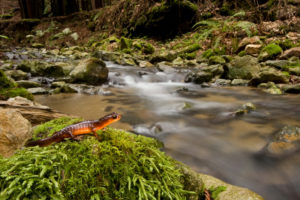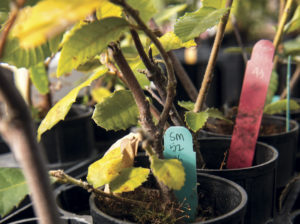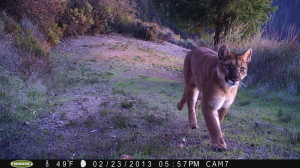Follow the spine of the Peninsula along Skyline Boulevard, and you’ll pass ten preserves belonging to the Midpeninsula Regional Open Space District. Roughly halfway down its winding route you’ll encounter the expanse of dense oaks and sun-swept grassland that is Russian Ridge Open Space Preserve. Perched atop the windward western side of the Santa Cruz Mountains, Russian Ridge appears much like the other preserves from the road. But beyond the drive-by sights lie spellbinding views and a grove of monumental, centuries-old oaks.
District senior resource manager Cindy Roessler is intimately familiar with the glories of this park. Exuberant and tremendously knowledgeable about the area, Roessler has spent the past 13 of her 30 years as a professional biologist with the district. She now lives on district property adjacent to Russian Ridge. The experience has given her a wealth of insight into this landscape and its wild residents.
“It’s subtle things,” Roessler says, “like what the favorite food of the deer is at this time of year: brown buckeye leaves. I had no idea. Every night I hear them crunch-crunch-crunching, even the fawns. They won’t touch them when they’re green.”
Roessler aims to showcase Russian Ridge this midsummer afternoon by taking me on a four-mile hike through the preserve that includes old growth forest, colorful wildflower meadows, and views extending from the Diablo Range to Monterey. For the past six years, the district has been developing valuable additions to the preserve: two extended trails and a new staging area, all on lands recently acquired from a former cattle ranch.
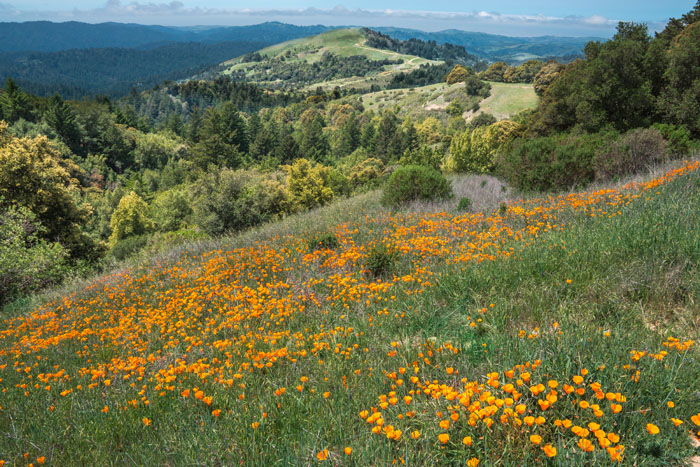
At Mindego Gateway, the new entrance and parking lot to the preserve, which sits just a mile past the intersection of Skyline Boulevard and Alpine Road, Roessler recounts a favorite discovery at the site. While the Open Space District was cleaning up the ranch yard, Roessler was tasked with relocating the snakes and tarantula-like Calisoga spiders that had been sheltering beneath the rubble. As she walked back and forth to the small meadow where she released her rescues, she began to realize that the selection of plants was subtly different from elsewhere in the park.
Here, native bunchgrasses such as blue wild rye, purple needlegrass, and California brome were intermixed with soap plant, mariposa lilies, brodiaeas, and yampa. “All these are plants that were used by the native people, and they’re denser here than I’ve seen anywhere else in our preserves,” Roessler says.
This observation agrees with what is known about the human history of the Alpine Road corridor. In centuries past, coastal Ohlone used this route to travel between San Francisco Bay and the coast. “Along the way, they would often plant and tend some of the native plants they used so when they stopped for the night there would be some food available,” Roessler says. The district has opted to manage this meadow with particular respect, asking volunteers to hand-pull invasive species such as yellow star thistle to maintain the blend of plants recalling the presence of the area’s original inhabitants.
To get an overview of this dramatic landscape, we follow a paved, wheelchair-accessible pathway extending west from the lot. The route curves through waving grasses to a wide patio. This is the Audrey C. Rust Commemorative Site, named for the retired executive director of the Peninsula Open Space Trust (POST), the nonprofit organization that purchased this former ranch for the district. Interpretive signs describe a human history that ranges from the coastal Ohlone to modern ranchers and identify major vista points. And what a sweeping panorama this is—grasslands in the foreground give way to unbroken forest, from the Pescadero watershed north to Butano Ridge directly ahead and to the fog-shrouded waters of Monterey Bay to the south.

Back at the parking lot we start down the preserve’s newest hiking route, a one-mile extension of the Ancient Oaks Trail. Winding gently past the headwater streams of Mindego Creek, the trail is a microcosm of the Santa Cruz Mountains, traversing oak-bay woodlands and wildflower fields, and leading past centuries-old heritage oaks and jaw-dropping vistas.
Within steps of the trailhead, a mixed evergreen broadleaf forest filters out the bright overhead sun. These bay laurels, oaks, tanoaks, and other trees engineer their own environment, cooling the air and keeping soils visibly moist. Alongside the trail we spot the slender, straplike leaves of Fernald’s iris, whose butter-yellow flowers with a splash of royal purple will emerge in spring; the creeping stems of California blackberry; and the lacy fronds of wood ferns.
We approach a canyon live oak growing next to the trail, its stout lower branches furred in moss. The green nap on the upper surface of one branch looks crumbly and worn. Roessler’s eyes light up. “On a big branch like this where the moss is smoothed off, if there are no people there regularly, it was probably made by a gray fox. I run wildlife camera traps in the parks, and I get pictures of them jumping into trees all the time.” This tendency toward tree climbing is unique among canids, as is the gray fox’s ability to retract its claws like a cat.
Roughly a mile from the trailhead, leaving the newest section of trail, we enter the realm of the ancient oaks. Stationed like guardians at the windward edge of the forest, these trees are colossi of their kind. Most have multiple trunks; one giant sports ten, each at least two feet in diameter. The trunks spread out (and out, and out) before turning skyward. Their canopies arc above like domes, covering an expanse that could envelop a good-size house. Some trees have even grown buttresses at the base of their trunks to help support their tremendous mass.
Virtually all of these ancients are canyon live oaks. Geography must play a large role in the grove’s formation, Roessler says. The trees stand directly in the path of Pacific storms, atop a ridge that slopes into open grassland. Blasted by both winter rain and summer fog, they collect an extra allotment of moisture year round. That extra water, together with abundant sunshine undimmed by other trees, has supported a grove of giants.
Roessler, however, has a second theory. She thinks human selection shaped the makeup of this grove. As San Francisco rebuilt after the 1906 fire and earthquake and the Bay Area attracted more residents, the Peninsula’s forests were denuded for housing materials and firewood. “They cleared almost everything from these hills, but they skipped these trees,” Rossler says. “Maybe the wood was too hard to harvest.” The canyon live oak is also known as the maul oak. Its exceptionally hard, dense wood was once used to make maul heads for splitting lumber. “There were other, bigger trees in the area, like redwoods, that grew straight and would yield a lot of board feet. If your business is to get as much cordage from these hills as you can, why spend your time cutting down the maul oak?” she asks.
If Roessler is right, the ancient oaks of Russian Ridge Open Space Preserve are first-growth trees never felled by settlers. It’s a conclusion supported by the exceptional girth of these oaks. Previous research suggests canyon live oaks from 10 to 18 inches in diameter can be up to 150 years old; the 16-or-so big trees in the ancient oaks grove have trunks ranging from 24 to 56 inches in diameter, which likely makes them at least three hundred years old.
Continuing on, we emerge from the grove of ancients into a broad meadow and turn east along the Charquin Trail. It’s hard to tell in midsummer, as the empty stems of European annual grasses rattle around us in the breeze, but the grasslands of Russian Ridge are renowned for having some of the most spectacular spring wildflower blooms in the Bay Area.
A few tenacious natives can be seen between those grasses even now. The hot pink blooms of clarkia; the yellow, daisy-like flowers of gum plant; and the tomato-red tassels of Indian paintbrush add daubs of color to an otherwise tawny brown landscape.
The district is working hard at Russian Ridge to return native forbs and bunchgrasses to these fields. After years of experimentation, Roessler and her colleagues have reached the point where they can shift monoculture fields of invasive annuals into meadows of lupine, tidytips, owl’s clover, California poppy, and purple needlegrass.
To achieve these results, they rely on techniques ranging from prescribed burns to mowing and herbicide. “You can’t weed every single invasive plant. Not only can’t we afford it, there aren’t that many volunteers in the world. So we have to use other tools and be smarter,” Roessler says.
Historic land use also affects the district’s restoration plans. Areas long tilled and colonized with invasives might require reseeding, using the same type of no-till drill seeder developed for prairie restoration in the Midwest. “It’s a lot of effort and you can’t do it all at once so you need to pick the best sites, get successes, and build on that,” Roessler says. The goal is to give natives a chance; “the locals will then duke it out among themselves and find their own micropatches,” she adds.
These manipulations might sound like meddling, but here in California, landscape management is an age-old practice. For millennia, the Ohlone and other tribes periodically set the landscape alight to encourage the growth of the plants they relied on for food and baskets. Fire also cleared forest undergrowth, making oak acorns, a dietary staple, easier to harvest.
Acorns pollinated this year on the canyon live oaks have just attained button size. Growing in pairs along leafy branch stems, the green nubs of the nuts are just beginning to emerge from the center of thick golden caps lapped by triangular scales. Over the next year, the nuts will elongate and dry to a rich chestnut brown before dropping in autumn of 2016. By contrast, coast live oaks are jackrabbit reproducers: Pollinated in one spring, their acorns ripen the same fall.
At the intersection with the Bay Area Ridge Trail, we head south on a path roughly parallel to Skyline Boulevard. In less than half a mile, the incline steepens briefly as we ascend the loftiest perch in the park: Borel Hill, the highest point in the middle reach of the Santa Cruz Mountains at 2,572 feet.
Clear days here offer breathtaking 360-degree views. To the east can be seen the multi-hued salt ponds and blue-green waters of San Francisco Bay, massive Mount Diablo, and even winter snows atop the Sierra Nevada; to the southwest, 60-mile views over the Santa Cruz Mountains, across Monterey Bay, and the verdant northern tip of the Santa Lucia Range. To the west lies Mindego Hill; in spring 2016, a new trail will lead hikers to its 2,137-foot summit. Beyond Mindego, forest and grassland are visible down to the blue line of the Pacific, except when shrouded in fog (a common occurrence).
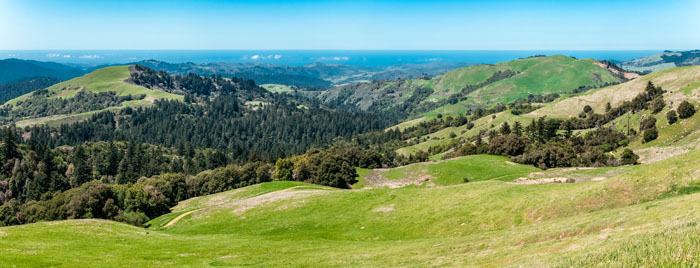
Hiking down the other side of the hill, we turn north briefly on the park’s Ridge Trail to the Bo Gimbal Trail, which takes us west and downhill. We dip into the shade of another tall woodland, populated solely by bay laurels. Located directly below and adjacent to the ancient oaks themselves, the grove is a cause of worry to Roessler and the district. Bay laurels are notorious carriers of sudden oak death (SOD), a disease that has been ravaging true oaks and other California native plants.
As we come up through the oak grove, we can see the bleached and skeletal remains of a canyon live oak that succumbed to the disease. Until five years ago, scientists had believed canyon live oaks were impervious to the disease. Then this tree and another in nearby Los Trancos Preserve died, showing rapid leaf browning and weeping blood-red bark cankers—classic symptoms of SOD. The district’s consultant SOD specialist, Ted Swiecki, suspects people emerging from the bay forest tracked the spores of the pathogen onto this tree as they climbed it.
To protect the ancient oaks at Russian Ridge, the district has removed any bay trees and branches within 15 feet of the ancients and taken the extra precaution of asking visitors to resist the temptation to climb the alluring old oaks.
“We have a very strong connection with trees, especially oaks. I’m glad people want to be around these trees; it’s part of their appreciating the reserve and getting a feeling of peace with their surroundings,” Roessler says. “But it might be better to just enjoy the sunset by standing next to the trees here rather than climbing them.” That’s a small price to pay to ensure future generations can travel along the path of the ancients.


